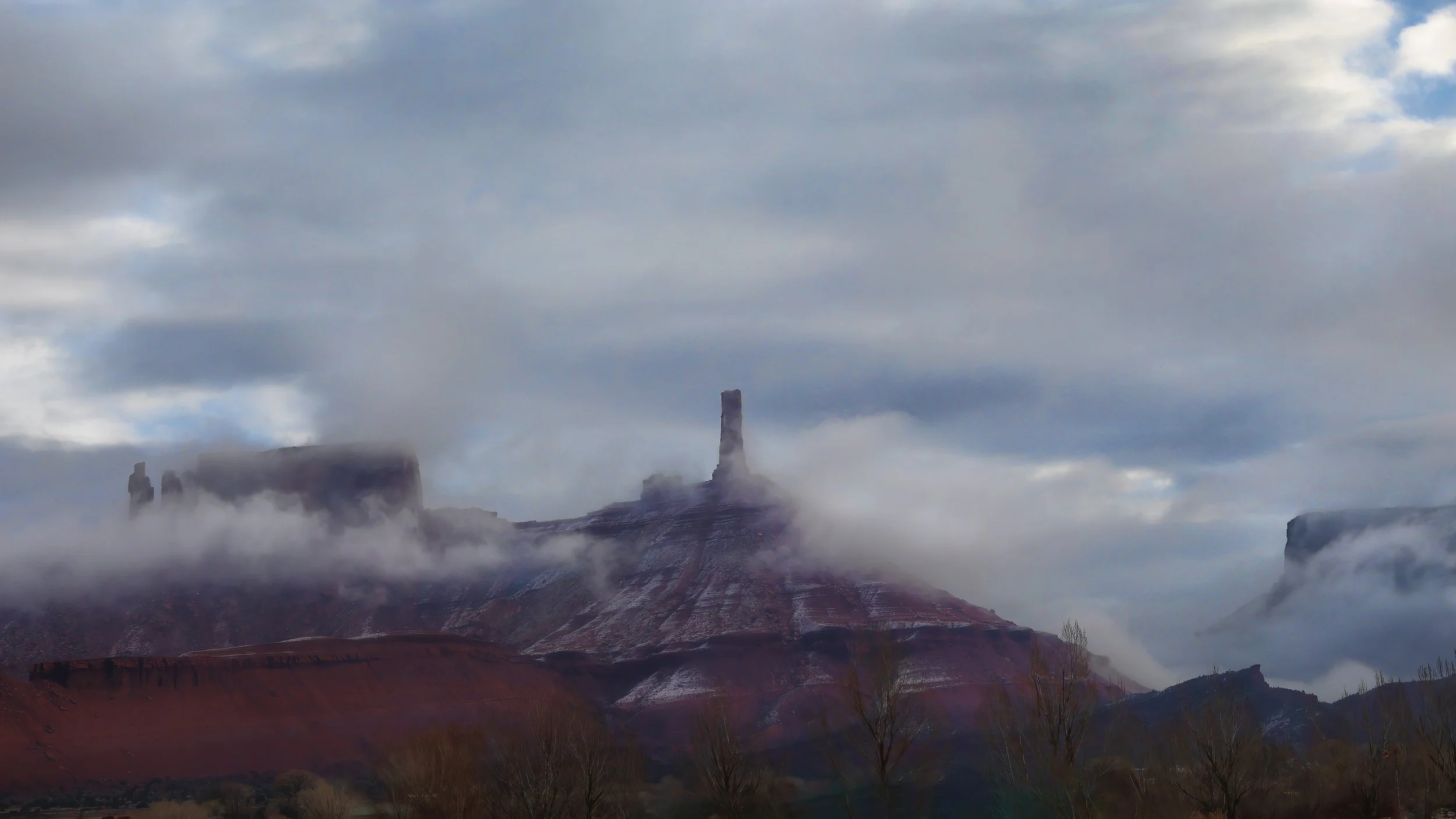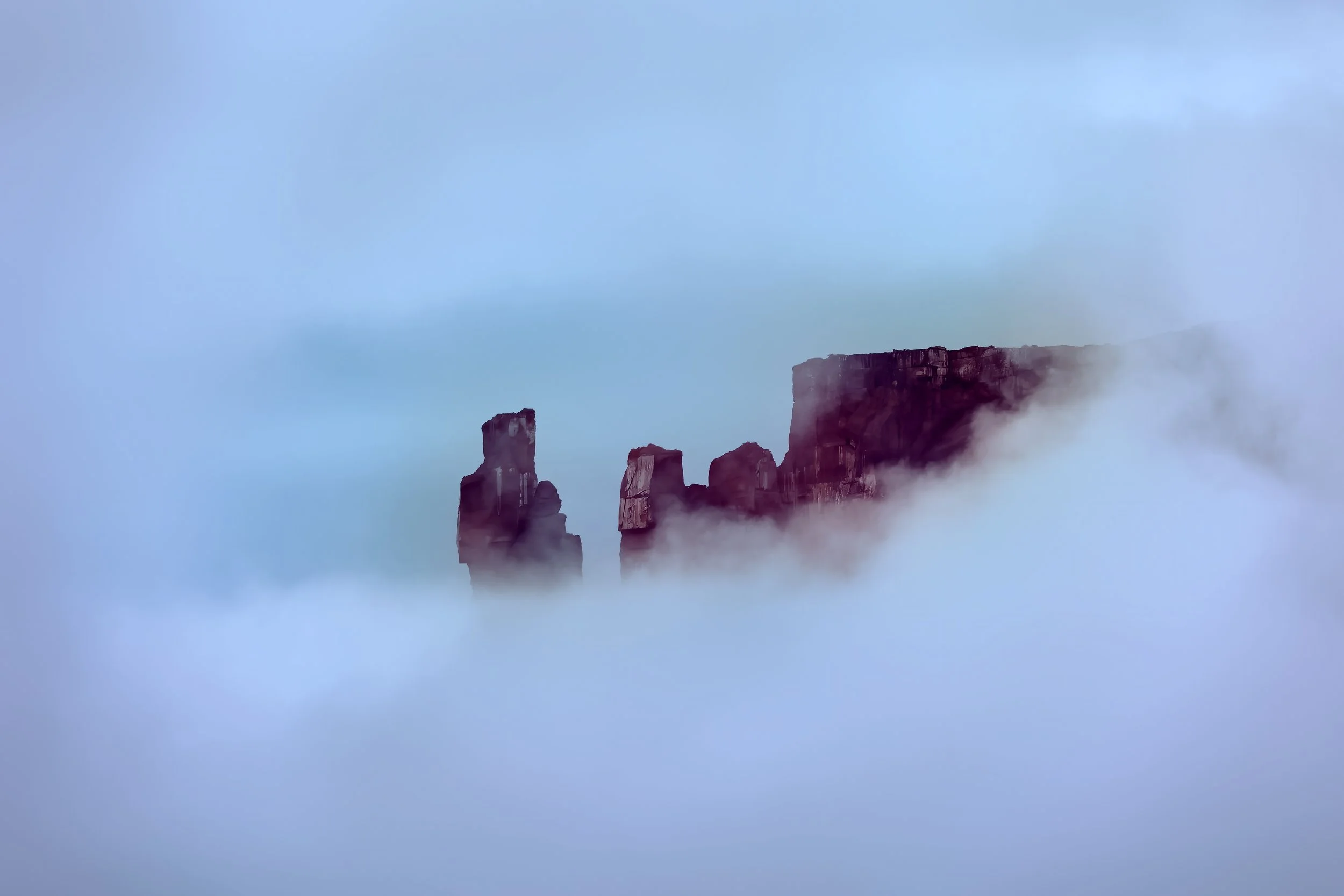that may bring snow and rain to the valley tomorrow. Here’s sunset this evening.
A dreary but welcome beginning...
to the new year sees the arrival of some moisture to the valley. About 0.1 inches (2.5 mm) of rain has fallen by midday.
Atmospherics against Porcupine Rim.
The year ends...
under very dry and mild conditions with an unimpressive snowpack in the high country. Look closely, the rising waxing gibbous Moon can be seen in the center of this image.
Snowpack in the La Sal Mountains is about half normal at the end of the calendar year 2025.
The Tower briefly emerges...
and then becomes obscured by low clouds as the latest early winter storm slowly passes, the first of which that dropped snow flurries on the valley this season. Meanwhile, the high country is off to a good start, sitting at 100% median snow water equivalent for this point in the water year.
Time series plot of snow water equivalent for the Lasal Mountain SNOTEL site.
Snow line sits at about 8,000 feet...
in the La Sal Mountains following several days of unsettled weather. About a half-inch (13 mm) of rain fell mid-valley at lower elevation.
Late afternoon atmospherics at Round Mountain.
A high elevation skift of snow...
still allows for zooming the trails lower in the valley the day after the storm. Winter approaches.
A sky full of cotton balls...
signals an incoming change in the weather with some moisture arriving late in the weekend.
Click on image to enlarginate.
Normally dry stream crossings...
turned into rapidly flowing muddy torrents within minutes in response to the passing of an intense thunderstorm cell. My neighbor and I were enrolled in the Bronco Off-Roadeo driving clinic and were out on the Dome Plateau trail undergoing guided training. It was absolutely perfect conditions to demonstrate the vehicle’s capabilities and the Bronco powered right through the mud and easily ascended wet and slippery slickrock.
Owl Draw on the Dome Plateau, north of Dewey Bridge.
Why the off road training? I am about to take possession of the 2025 Bronco Badlands/Sasquatch next week in Moab that I had ordered in late June this year. I’m somewhat excited!
3 November 2025 UPDATE: The Bronco has landed in Moab and is being prepped by the dealer.
Autumn colors on the Dome Plateau...
in Tub Canyon appear brilliantly luminous under foreboding skies of an approaching storm.
Porcupine Rim appears on fire...
at sunset this evening, while Adobe Mesa glows warmly in the east.
The Priest peeks out of the mist...
on a dreary and drippy day in Castle Valley where nearly 1.5 inches (38 mm) of welcome rain has fallen during the last several days.
A calm and smoke free sky...
allows for the lovely reflection of cirrus clouds on the mirrored surface of Fish Lake early this morning. It feels like I’ve left Mars and returned to Earth.
A menacing-looking storm cell...
blossomed over the La Sal Mountains yesterday afternoon bringing lightning to the high country but, alas, no moisture whatsoever to the lower canyons.
Quite a difference overnight...
in air quality as a persistent smoky airmass clears the canyons, seen here in comparative images into Professor Valley from a high vantage point on my daily ride.
THE DAY BEFORE around 7:45 am MDT.
TODAY around 8:00 am MDT where one can easily spy Fisher Towers six miles (9.6 km) away.
A highly hazy horizon...
nearly obscures Castle Valley in the distance, likely due to wildfires burning near Bryce Canyon and in northern Arizona. Here’s the view across the sandstone expanse of Arches National Park caught early this morning from the Moab Brands mountain bike trail system.
Parriott Mesa, the Priest & Nuns, Castleton Tower and Adobe Mesa are all visible 15.5 miles (~25 km) away from this vantage point on the Moab Brands mountain bike trail system.
An early morning start...
to my daily rides is increasingly necessary as it’s heading toward 100° F by the weekend.
This morning: Panorama of the Round Mountain Annex to Castle Valley National Park. (Click on image to expandify.)
The singletrack at 7:45 am MDT. Cool. Quiet. Critters. Sublime.
The snow is nearly gone...
and summertime storm clouds blossom over the high La Sal Mountains. Less than two weeks until the summer solstice.
UPDATE: Peak flow on the Colorado River has likely just occurred, capping an unremarkable spring runoff. Here’s the one year hydrograph for the Colorado River at the Cisco gage showing that this year’s peak flow (blue line) is one-third of last year’s value (brown line) and less than half the median value (dotted line).
The archetypical Hollywood Western sky...
paints a postcard picture today, so here it is for all to enjoy. They really should consider making movies out here.
Click on image to expandinate.
Several dreary and misty days...
in the low country has bolstered the snowpack in the high country, now standing at 76% of the median snow water equivalent, following very closely the trajectory of the 2022 water year.
This year’s snowpack (black line) compared with 2022 (green line).
Soft light over Porcupine Rim...
at sunset with high wind and freeze warnings in the forecast.
























